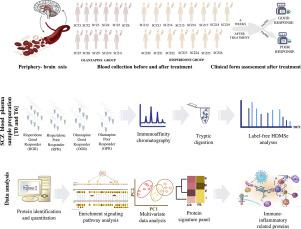Journal of Proteomics ( IF 3.3 ) Pub Date : 2020-05-26 , DOI: 10.1016/j.jprot.2020.103813 Sheila Garcia-Rosa 1 , Benilton S Carvalho 2 , Paul C Guest 1 , Johann Steiner 3 , Daniel Martins-de-Souza 4

|
Antipsychotics are the main line of treatment for schizophrenia. Even though there are significant rates of medication drop out due to side effects and limited response of approximately 50% of patients. This is likely due to incomplete knowledge in how these drugs act at the molecular level. To improve treatment efficacy during the critical early stages of schizophrenia, we aimed to identify molecular signatures at baseline (T0) for prediction of a positive response to the atypical antipsychotics olanzapine and risperidone after 6 weeks (T6) treatment. Blood plasma samples were processed and analyzed by label-free quantitative shotgun proteomics using two-dimensional nano-liquid chromatography, coupled online to a Synapt G2-Si mass spectrometer. Data were obtained in MSE mode (data-independent acquisition) in combination with ion-mobility (HDMSE). We were able to identify a potential panel of proteins that might predict a positive outcome to olanzapine and risperidone treatment. The proteins found to be differentially abundant between T0 and T6 in good responders compared to poor responders were analyzed in silico for enrichment pathways and found to be mostly involved with immune system functions. This data can contribute to better understand the biochemical signaling mechanisms peripherally triggered by antipsychotic medication and eventually used to develop surrogate biomarker tests to help improve treatment outcomes and guide development of new treatment approaches.
Significance
The application of proteomics to the study of the atypical antipsychotic effects on the blood plasma proteome from schizophrenia patients could help in the search for new targets to improve the current therapies, as well as in the development of new therapeutic strategies. In this original article, we provided clues that atypical antipsychotics might be associated with good response by modulating proteins that play a role in inflammation and/or immune system pathways. In addition, the proteins with differential abundance found in the comparison between good and poor responders at the baseline might compose a signature for prediction of response effectiveness.
中文翻译:

奥氮平和利培酮诱导的精神分裂症患者血浆蛋白质组学调节。
抗精神病药是精神分裂症的主要治疗方法。即使由于副作用和大约50%的患者反应受限而导致药物的大量流失。这可能是由于对这些药物如何在分子水平上起作用尚不完全了解。为了在精神分裂症的关键早期阶段提高治疗效果,我们旨在确定基线(T0)的分子特征,以预测6周(T6)治疗后对非典型抗精神病药奥氮平和利培酮的阳性反应。血浆样品经过处理,并使用二维纳米液相色谱仪通过无标记定量processed弹枪蛋白质组学进行了分析,并在线连接到Synapt G2-Si质谱仪。数据在MS E中获得模式(与数据无关的采集)与离子迁移率(HDMS E)结合使用。我们能够鉴定出一组可能预测奥氮平和利培酮治疗阳性结果的蛋白质。通过计算机分析了高反应者与不良反应者相比在T0和T6之间差异丰富的蛋白质,并通过计算机分析了其富集途径,发现这些蛋白质主要与免疫系统功能有关。这些数据有助于更好地了解抗精神病药物外围触发的生化信号传导机制,并最终用于开发替代生物标志物测试,以帮助改善治疗效果并指导新治疗方法的开发。
意义
蛋白质组学在精神分裂症患者血浆蛋白组学上的非典型抗精神病作用研究中的应用可能有助于寻找新的靶点以改善当前的治疗方法,并有助于开发新的治疗策略。在这篇原始文章中,我们提供了线索,即非典型抗精神病药可能通过调节在炎症和/或免疫系统途径中起作用的蛋白质而与良好的反应有关。另外,在基线时,良好和不良反应者之间的比较中发现的差异丰度的蛋白质可能构成预测反应有效性的标志。



























 京公网安备 11010802027423号
京公网安备 11010802027423号